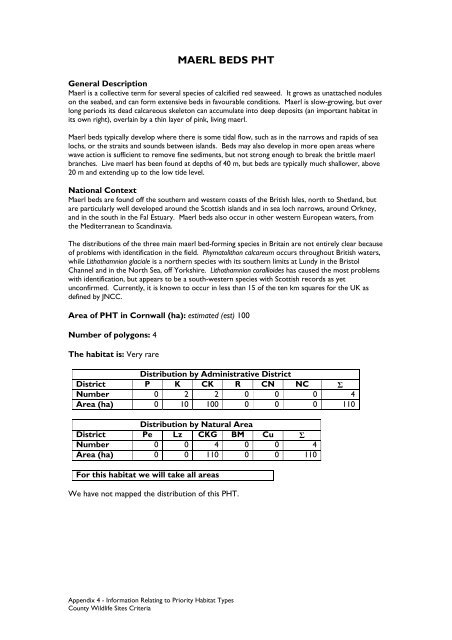County Wildife Site Criteria for Cornwall Appendices
County Wildife Site Criteria for Cornwall Appendices
County Wildife Site Criteria for Cornwall Appendices
You also want an ePaper? Increase the reach of your titles
YUMPU automatically turns print PDFs into web optimized ePapers that Google loves.
MAERL BEDS PHTGeneral DescriptionMaerl is a collective term <strong>for</strong> several species of calcified red seaweed. It grows as unattached noduleson the seabed, and can <strong>for</strong>m extensive beds in favourable conditions. Maerl is slow-growing, but overlong periods its dead calcareous skeleton can accumulate into deep deposits (an important habitat inits own right), overlain by a thin layer of pink, living maerl.Maerl beds typically develop where there is some tidal flow, such as in the narrows and rapids of sealochs, or the straits and sounds between islands. Beds may also develop in more open areas wherewave action is sufficient to remove fine sediments, but not strong enough to break the brittle maerlbranches. Live maerl has been found at depths of 40 m, but beds are typically much shallower, above20 m and extending up to the low tide level.National ContextMaerl beds are found off the southern and western coasts of the British Isles, north to Shetland, butare particularly well developed around the Scottish islands and in sea loch narrows, around Orkney,and in the south in the Fal Estuary. Maerl beds also occur in other western European waters, fromthe Mediterranean to Scandinavia.The distributions of the three main maerl bed-<strong>for</strong>ming species in Britain are not entirely clear becauseof problems with identification in the field. Phymatolithon calcareum occurs throughout British waters,while Lithothamnion glaciale is a northern species with its southern limits at Lundy in the BristolChannel and in the North Sea, off Yorkshire. Lithothamnion corallioides has caused the most problemswith identification, but appears to be a south-western species with Scottish records as yetunconfirmed. Currently, it is known to occur in less than 15 of the ten km squares <strong>for</strong> the UK asdefined by JNCC.Area of PHT in <strong>Cornwall</strong> (ha): estimated (est) 100Number of polygons: 4The habitat is: Very rareDistribution by Administrative DistrictDistrict P K CK R CN NC ΣNumber 0 2 2 0 0 0 4Area (ha) 0 10 100 0 0 0 110Distribution by Natural AreaDistrict Pe Lz CKG BM Cu ΣNumber 0 0 4 0 0 4Area (ha) 0 0 110 0 0 110For this habitat we will take all areasWe have not mapped the distribution of this PHT.Appendix 4 - In<strong>for</strong>mation Relating to Priority Habitat Types<strong>County</strong> Wildlife <strong>Site</strong>s <strong>Criteria</strong>
















